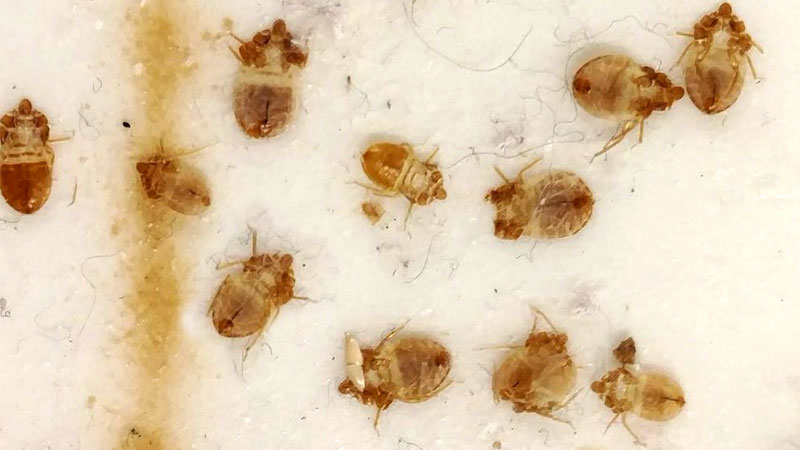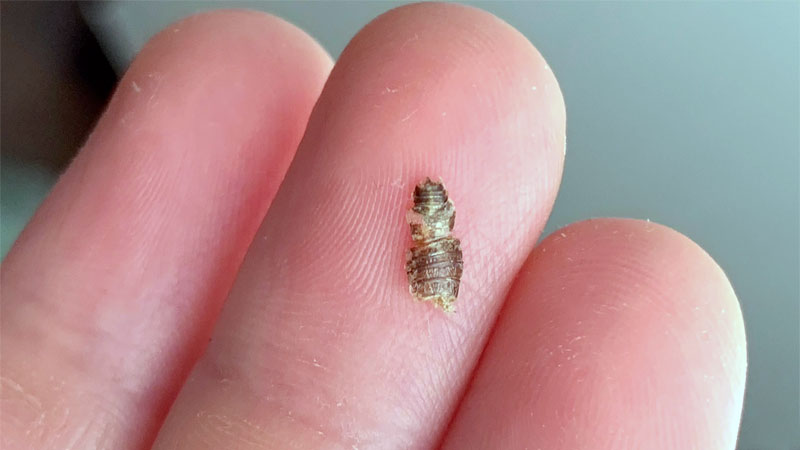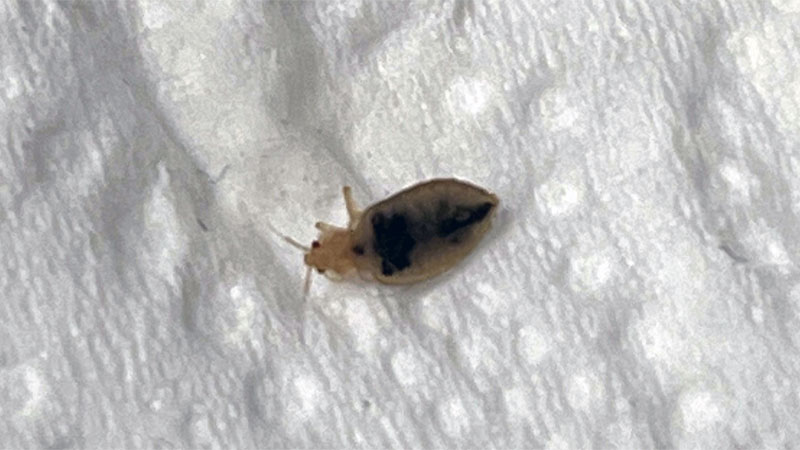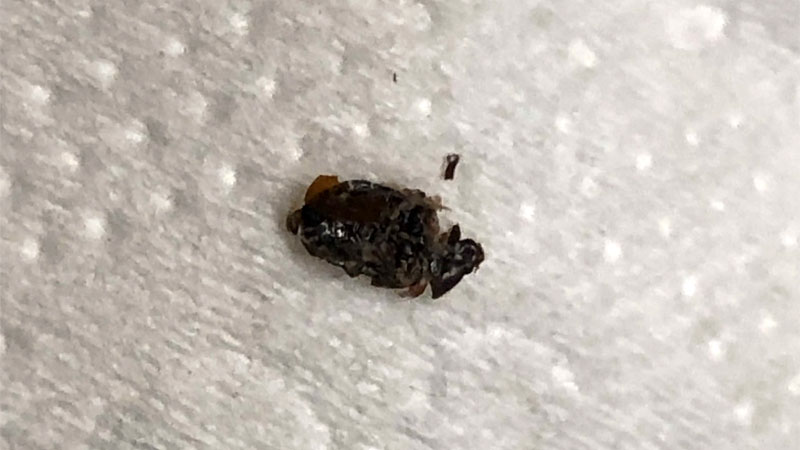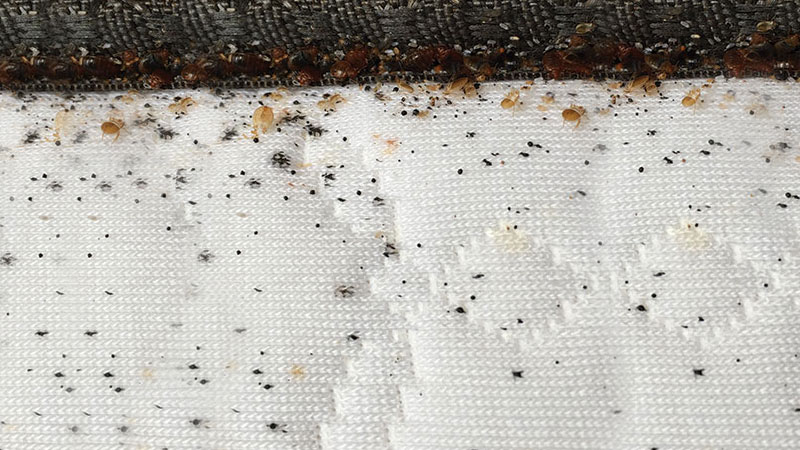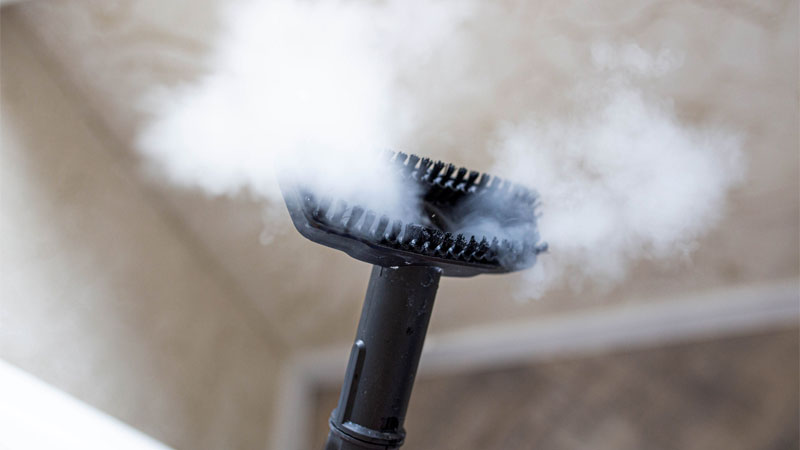There are a lot of myths about bed bugs out there, but one of the ones we hear a lot is that bed bug bites are the first sign of an infestation. However, this isn’t always true.
Not only can those bites be from some other critter, but it’s also entirely possible you could be bitten without showing any symptoms or the red marks don’t appear right away.
Unless you suspect you were exposed to bed bugs, there’s a good chance your first sign of an infestation will actually be bed bug casings. These shells can be quite a surprise when you spot them. However, before you go grabbing the rubbing alcohol, take a deep breath and look closer. You might be surprised (and likely grossed out).
A Species Disclaimer
Before we get into discussing bed bug casings, it’s important to note that there is more than one species of bed bug. The common bed bug (Cimex lectularius) is the one you’re most likely to run into and can be found throughout much of the northern hemisphere.
The other species, the tropical bed bug (Cimex hemipterus), is found in the southern states and isn’t as widespread as the common bed bug.
These two species have slightly different life cycles and can vary in other factors as well. We’ll be focusing on measurements and timeframes which fit within the ranges of both species.
In other words, depending on which type of bed bug infestation you have, your mileage may vary (YMMV), but only by a tiny amount.
Identifying Bed Bug Shells
When you spot insect casings in your bedroom, it’s easy to jump to conclusions and blame bed bugs. However, there are many other bedroom bugs that could be leaving casings as well.
So Other Insects Shed Their Skin?
That’s right. In fact, all insects have to do this in order to grow.
Bed bug shells are actually exoskeletons and are too rigid for the insect to grow, so they molt,. The shed casing reveals a softer shell that hardens to a lareger size. Sometimes the new shell also bears a slightly different shape or color.
What Do Bed Bug Shell Casings Look Like?
When you first spot a bed bug casing, you might freeze, waiting for it to move. This is because the casings are a perfect replica of the bed bug itself with one exception – it’s hollow, so you can see through it.
These casings are a reddish brown just like the bed bug (remember, the exoskeleton is an insect equivalent of skin as well as the skeletal structure). Depending on the age of the bed bug, the shells can be a s small as 1/16 inch up to 3/8 inches long.
Are They Hard or Soft?
In the earliest instars, bed bug nymphs have slightly softer shells, but they’re still pretty hard overall. Remember, the exoskeleton of a bug is exactly what it sounds like – a skeleton on the outside of their body instead of inside. As it goes through successive instars towards adulthood, the bed bug shells will become increasingly hard.
Even though the shed casings are hollow and somewhat transparent, you’ll find they still take a little effort to crush. This resilience not only protects the bed bug during its life, but will also result in fully intact shells once shed.
Do the Shells Have Legs?
Initially, bed bug shells will have legs just like the insect that shed them. However, these hollow leg casings are brittle and can break off over time. Thus it’s possible to discover shells that have no legs or only some legs.
Where Are the Shells Typically Found?
Bed bug casings are found in a wide range of crazy places, and you’ll often not even notice them. For example, you’re likely to spot some casings in your bed but completely miss the ones hidden behind loose wallpaper or picture frames, under or behind the bed, or in the edges or creases of carpets and upholstery.
But wait, there’s more! Bed bugs will also molt in even stranger places such as zippers, buttons, your box spring or mattress seams, inside electronic devices, in the heads of screws, hinges… The list of potential spot can be almost endless.
See Also: Can Bed Bugs Live in Carpet?
Why Do Bed Bugs Shed Their Skin in Such Strange Places?
Keep in mind, bed bugs hate all sorts of things, and they tend to crave dark, tight spaces. This protects them from potential predators and also allows them to lay their eggs where they’ll remain safe.
This habit is also one of the big reasons bed bug infestations can become so difficult to treat. In fact, the only real reason you might find the casings in your sheets is because of their feeding habits.
How Often Do Bed Bugs Shed Their Shell?
Generally speaking, bed bugs nymphs will reach the end of each instar in about a week at temperatures of 72° Fahrenheit, but tend to shed their exoskeletons on average every 35 to 48 days, sometimes longer if they haven’t had fed on human blood.
A bed bug goes through five instars before reaching adulthood, molting between each one. Because a bed bug can’t molt without having a blood mean, a single instar can potentially last over a year.
Can They Really Last a Year Without Food?
Younger nymphs may live only 20 days without food, depending on the temperature and humidity levels. Each successive instar becomes more durable and can go longer without food.
While it hasn’t been observed in nature, laboratory studies have recorded a bed bug lasting for over 400 days without food when kept at lower temperatures!
How Long Does the Process Take?
As mentioned, each molting phase can be as soon as a week after the previous one under ideal conditions but normally it takes a little over a month. The molting process itself doesn’t take very long, which is why you may find the little brown exoskeletons in your bed.
Do Adult Bed Bugs Shed Their Skin as Well?
No, once reaching the adult stage, the bed bug has achieved its full size and no longer needs to molt. The adult exoskeleton is at its hardest at this point. However, the underside of the abdomen remains soft and somewhat flexible. This allows the abdomen to swell when the bed bug has a blood meal.
What to Do if You Find Bed Bug Shells
So now that you know what bed bug casings look like and how they happen, let’s get into the big questions: What they mean and what to do about them.
What Does It Mean If You Find Bed Bug Casings?
The obvious meaning is that you have bed bugs, but there’s more to the story.
You can determine what instar the bed bug is by measuring the length of the casing. This will give you a better idea of how bad the potential infestation is. For example, the approximate length of each instar is:
- First Instar = 1/20”
- Second Instar = 1/16”
- Third Instar = 1/10”
- Fourth Instar = 1/8”
- Fifth Instar = 1/5”
If your casing is that of a fifth instar nymph, it might have been a hitchhiker or could be from an existing infestation. However, if it’s a first or second instar, there’s a good chance the bed bug hatched from an existing infestation. This is because only adults are able to reproduce and can only store sperm for about a week.
This brings us to another problem:
What Causes Bed Bugs In the First Place?
Bed bugs don’t simply appear, although it can seem that way. In some rare cases, they may wander into your home through entry points, but they usually hitchhike.
When you are exposed to bed bugs, one or two may hide in the creases of your clothing or in something you’re carrying. They’ll remain hidden until you get home, at which point they’ll scurry for cover and eventually end up somewhere humans tend to rest, such as the bedroom or (less often) the living room.
If the bed bug was an inseminated adult or you have a pair of instars, it doesn’t take long for a population explosion. Both species will prodsuce only up to 10 eggs per day. However, while tropical bed bugs only lay about 50 in their lifetime, the common bed bug can lay between 200 and 500!
When you start seeing bed bug egg casings or translucent shells, you will need to either immediately get rid of the bed bugs by yourself or call in an exterminator.
Tips For Dealing With Bed Bug Casings
Getting rid of bed bugs isn’t a simple process by any means, and we won’t get into detail about that process here. However, some of the following methods for removing bed bug exoskeletons can also kill the bugs themselves, helping you to at least reduce the population.
Keep in mind, casings are usually found in or near places where the bed bugs have been laying eggs, so by dealing with the casings, you could also be eliminating many of the eggs.
Step #1 – Locate Other Casings
Where there’s one bed bug, there’s almost certainly more, so begin a thorough inspection to try and locate other casings. Remember, you’ll find them in cracks, crevasses, and other hard to reach places.
Also, keep an eye out for fecal stains, which look like dark spots on your mattress. Make note of these locations for the next steps.
Step #2 – Steam Clean
If you own a steam cleaner (and honestly, everyone should invest in one), you can run it over any spots you’ve found casings. Just make sure those surfaces can handle heat and moisture. This will get a lot of deep-seated dirt out of upholstered furniture. More importantly, the heat can kill bed bugs and their eggs.
The trick is to apply the steamer’s heat evenly if using a non-commercial model. This is because it can take several minutes for a bed bug to die at 140 degrees. Be sure to get into all the crevasses, such as mattress folds, cracks in bed frames, and other common hiding spots.
If you don’t have a steamer, you can use a regular vacuum cleaner. However, this won’t be as effective and won’t actually kill any eggs or bed bugs it manages to suck up. Be sure to empty the canister or bag safely so these resilient pests can’t escape.
- CLEAN. DISINFECT. SANITIZE. DEGREASE. DEODORIZE. ANY SURFACE. CHEMICAL-FREE.
- POWERFUL STEAM CLEANER: up to 275°F/135°C. Best multi purpose steamer for...
- HEAVY-DUTY & LARGE CAPACITY: Up to 50 minutes of cleaning time per fill up.
Step #3 – Dry Clean
Grab anything that can be washed near where you found the casings and chuck them into the dryer on high heat. You will want to securely bag these items on the way to the dryer to prevent any escapes.
While you can run them through the washer first, the eggs won’t be affected by soapy water and can only be killed by high heat.
Step #4 – Gear Up
Unless you’re going all out, the next step will be to try and keep the little nasties hungry until you can take whatever steps you need to to exterminate them. This involves making sure you wear clothing to bed.
Socks and pajamas may not be the most romantic thing to sleep in. However, bed bugs aren’t able to climb into clothes. Therefore, the less exposed skin you have, the harder it will be for them to bite.
You can also help fend off these tiny vampires by eating garlic or using essential oils.
When All Else Fails…
Due to an overuse of chemical pesticides in the mid 20th century, bed bugs have become really tough to kill. Sure, a bed bug bomb will often kill them, but you need to repeat the process using a different brand to get the youngest life stages. Using the same brand increases the risk of superbugs.
But there’s a more effective method out there. When you see any sign of bed bugs in the house and suspect these tiny, blood-sucking pests have taken up residence, don’t be ashamed to call a professional exterminator.
Their pricing may seem expensive at first, but you’re getting a full package. This includes a thorough inspection and assessment, treatment, and followup visits to ensure nothing survived.
Remember, spotting the shells of bed bugs is a sure sign that you have nymphs. Nymphs equal a high risk of reproduction and a population explosion. Don’t wait around when you spot this obvious sign of an infestation!
- How to Get Rid of Hawks - March 8, 2024
- How to Get Rid of Pill Bugs (Rolly Pollies) - March 1, 2024
- How to Get Rid of Groundhogs (Woodchucks) - February 5, 2024

